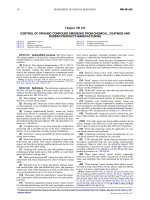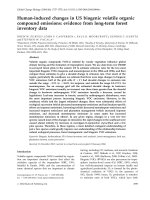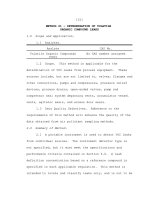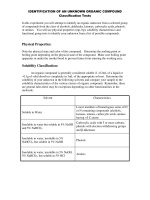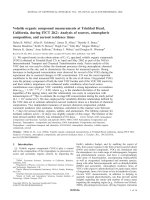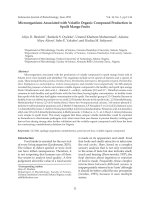National Volatile Organic Compound Emission Standards For Consumer Products -- Background for Promulgated Standards potx
Bạn đang xem bản rút gọn của tài liệu. Xem và tải ngay bản đầy đủ của tài liệu tại đây (163.85 KB, 73 trang )
National Volatile Organic
Compound Emission Standards
For Consumer Products
Background for Promulgated Standards
E P A
Air
United States
Environmental Protection
Agency
Office of Air Quality
Planning and Standards
Research Triangle Park NC 27711
EPA-453/R-98-008b
August 1998
EPA-453/R-98-008b
NATIONAL VOLATILE ORGANIC COMPOUND EMISSION STANDARDS
FOR CONSUMER PRODUCTS BACKGROUND FOR PROMULGATED STANDARDS
Emission Standards Division
U.S. Environmental Protection Agency
Office of Air and Radiation
Office of Air Quality Planning and Standards
Research Triangle Park, North Carolina 27711
August 1998
ii
DISCLAIMER
This report has been reviewed by the Emission Standards Division
of the Office of Air Quality Planning and Standards, EPA, and
approved for publication. Mention of trade names or commercial
products is not intended to constitute endorsement or
recommendation for use. Copies of this report are available from
National Technical Information Services, 5285 Port Royal Road,
Springfield, VA 22161.
iii
TABLE OF CONTENTS
Page
1.0 LIST OF COMMENTERS 1-1
2.0 SUMMARY OF PUBLIC COMMENTS 2-1
2.1 LEGISLATIVE AUTHORITY 2-1
2.1.1 Application of the Section 183(e)(2)(B)
Factors 2-1
2.1.2 National Rule vs. Control Techniques
Guidelines 2-3
2.1.3 Regulation of a Subset of Consumer
Products 2-4
2.2 PROPOSED STANDARDS 2-6
2.2.1 Applicability . 2-6
2.2.2 Definitions 2-14
2.2.3 Standards for Consumer Products 2-29
2.2.4 Innovative Product Provisions 2-37
2.2.5 Code-dating 2-37
2.2.6 Variances 2-38
2.2.7 Test Methods 2-41
2.2.8 Charcoal Lighter Material Compliance
Testing Protocol 2-41
2.2.9 Recordkeeping and Reporting 2-43
2.3 IMPACTS 2-52
2.3.1 Cost Effectiveness 2-52
2.4 MISCELLANEOUS ISSUES AND CLARIFICATIONS 2-57
LIST OF TABLES
1-1 LIST OF COMMENTERS ON PROPOSED NATIONAL EMISSION
STANDARDS FOR CONSUMER PRODUCTS 1-2
1-1
1.0 LIST OF COMMENTERS
A list of the commenters, their affiliations, and
Environmental Protection Agency (EPA) docket number assigned
to their correspondence is given in table 1-1.
1-2
TABLE 1-1. LIST OF COMMENTERS ON PROPOSED NATIONAL
EMISSION STANDARDS FOR CONSUMER PRODUCTS
Docket number Commenter and affiliation
a
IV-D-01 J. Janeczek Jr., P.E.
Capital Cities/ABC, Inc.
New York, New York
IV-D-02 R.D. Elliott
Executive Director
Southwest Air Pollution
Control Authority
Vancouver, Washington
IV-D-03 S.R. Cornes
Regulatory Compliance Specialist
The Solaris Group
San Ramon, California
IV-D-04 G.F. Tappan
Section Chief
Regulatory Affairs
Block Drug Company, Inc.
Jersey City, New Jersey
IV-D-05 H. Hironaka
Vice President
F-Matic of America
American Fork, Utah
IV-D-06 A.W. Effinger, Esq.
General Counsel
American Pet Products
Manufacturers Association, Inc.
Greenwich, Connecticut
IV-D-07 W.M. Smiland
Law Offices of Smiland & Khachigian
Los Angeles, California
IV-D-08 S.C. Steinback
Manager of State Legislative Affairs
International Sanitary Supply
Association, Inc.
Lincolnwood, Illinois
IV-D-09 B.F. Mannix
President
Buckland Mill Associates
Gainesville, Virginia
TABLE 1-1. LIST OF COMMENTERS ON PROPOSED NATIONAL
EMISSION STANDARDS FOR CONSUMER PRODUCTS
(CONTINUED)
Docket number Commenter and affiliation
a
1-3
IV-D-10 W.K. Lim
President
Aerosol Services Company, Inc.
City of Industry, California
IV-D-11 B. Mathur
Chief
Bureau of Air
State of Illinois
Environmental Protection Agency
Springfield, Illinois
IV-D-12 S.E. Dudley
Vice President
Director of Environmental Analysis,
Economists, Incorporated
Washington, DC
IV-D-13 B.A. Kwetz
Director
Division of Air Quality Control
Commonwealth of Massachusetts
Department of Environmental Protection
Boston, Massachusetts
IV-D-14 R. Sedlak
Technical Director
The Soap and Detergent Association
New York, New York
IV-D-15 D.I. Greehaus
National Automobile Dealers Association
McLean, Virginia
IV-D-16 R.G. Sliwinski, Chief
Stationary Source Inventory
and Planning Section
Division of Air Resources
New York State Department of
Environmental Conservation
Albany, New York
IV-D-17 W.F. Holman, Association Director
Laundry & Cleaning Products
Procter & Gamble Company
Cincinnati, Ohio
TABLE 1-1. LIST OF COMMENTERS ON PROPOSED NATIONAL
EMISSION STANDARDS FOR CONSUMER PRODUCTS
(CONTINUED)
Docket number Commenter and affiliation
a
1-4
IV-D-18 D. Stringham, Director
Regulatory and State Government Affairs
Safety-Kleen
Elgin, Illinois
IV-D-19 D. Raymond
Division Director of Regulatory Affairs
Sherwin-Williams Diversified
Brands, Inc.
Solon, Ohio
IV-D-20 Chlorobenzene Producers Association
Washington, DC
IV-D-21 E.J. Moyer
Director of Regulatory Affairs
Reckitt & Colman, Inc.
Montvale, New Jersey
IV-D-22 K.W. Chilton, Ph.D.
Director
Center for the Study of American
Business
Washington University in St. Louis
St. Louis, Missouri
IV-D-23 G.A. Green
Division Administrator
Air Quality
Department of Environmental Quality
State of Oregon
Portland, Oregon
IV-D-24 D.F. Theiler, Director
Bureau of Air Management
Department of Natural Resources
State of Wisconsin
Madison, Wisconsin
IV-D-25 P.M. Meehan
Director of Product Safety
Environment and Regulatory Compliance
The Clorox Company
Pleasanton, California
TABLE 1-1. LIST OF COMMENTERS ON PROPOSED NATIONAL
EMISSION STANDARDS FOR CONSUMER PRODUCTS
(CONTINUED)
Docket number Commenter and affiliation
a
1-5
IV-D-26 L.L. Calhoun
Environmental and Health Regulatory
Affairs and T.A. Threet
Legal Department
The Dow Chemical Company
Midland, Michigan
IV-D-27 R.H. Roos
Vice President & General Counsel
Sally Beauty Company, Inc.
Denton, Texas
IV-D-28 J.M. Spagnoli
Agriculture Division
Bayer Corporation
Kansas City, Missouri
IV-D-29 D. Pearson
Executive Director
Texas Natural Resource
Conservation Commission
Austin, Texas
IV-D-30 L.A. Braem
Director Environmental Law
Schering-Plough HealthCare Products
Liberty Corner, New Jersey
IV-D-31 W.D. Anderson
Managing Director
Resilient Floor Covering Institute
Rockville, Maryland
IV-D-32 J. Gledhill
The EOP Group
Washington, DC
IV-D-33 R. Engel, President
Chemical Specialties
Manufacturers Association
Washington, DC
IV-D-34 L.A. Spurlock, Ph., CAE
Chemical Manufacturers Association
Arlington, Virginia
TABLE 1-1. LIST OF COMMENTERS ON PROPOSED NATIONAL
EMISSION STANDARDS FOR CONSUMER PRODUCTS
(CONTINUED)
Docket number Commenter and affiliation
a
1-6
IV-D-35 R.E. Mitchell
Chairman of the Board
Dunn-Edwards Corporation
Los Angeles, California
IV-D-36 D.K. Johnson
Principal Facility Environmental
Control Engineer
Environmental Quality Office
Ford Motor Company
Dearborn, Michigan
IV-D-37 J. A. Word
Associate Counsel
Conair Corporation
Stamford, Connecticut
IV-D-38 D.M. Adams
Vice President-Quality Assurance
Regulatory Affairs and Consumer Affairs
American Home Food Products, Inc.
Madison, New Jersey
IV-D-39 R.M. Horton
Regulatory & Sales Support Manager
Dragon Corporation
Roanoke, Virginia
IV-D-40 F.N. Romano
Chairman of the Board
Chief Executive Officer
Key West Fragrance &
Cosmetic Factory, Inc.
Key West, Florida
IV-D-41 W.C. Balek
Director of Legislative Affairs
International Sanitary Supply
Association, Inc.
Lincolnwood, Illinois
IV-D-42 I.S. Combe
Chairman
Combe Incorporated
White Plains, New York
TABLE 1-1. LIST OF COMMENTERS ON PROPOSED NATIONAL
EMISSION STANDARDS FOR CONSUMER PRODUCTS
(CONTINUED)
Docket number Commenter and affiliation
a
1-7
IV-D-43 B. Costino
Vice President
Marianna Manufacturing &
Distribution Center
Omaha, Nebraska
IV-D-44 M.A. Dirzis
Director
Government Affairs
Avon Products, Inc.
New York, New York
IV-D-45 E.O. Sullivan
State of Maine
Department of Environmental Protection
Augusta, Maine
IV-D-46 T.J. Donegan, Jr.
Vice President-Legal and General Counsel
The Cosmetic, Toiletry, and
Fragrance Association
Washington, DC
IV-D-47 P.T. Haluza
Director
Government Relations & Public Affairs
and
L. Hansen, Executive Secretary
Automotive Chemical
Manufacturers Council
Washington, DC
IV-D-48 R.N. Hiatt
Chairman
Maybelline, Inc.
Memphis, Tennessee
IV-D-49 G.T. Blair
Haarmann & Reimer Corporation
Springfield, New Jersey
IV-D-50 S.I. Sadove
President
Clairol
Stamford, Connecticut
TABLE 1-1. LIST OF COMMENTERS ON PROPOSED NATIONAL
EMISSION STANDARDS FOR CONSUMER PRODUCTS
(CONTINUED)
Docket number Commenter and affiliation
a
1-8
IV-D-51 E. Zeffren, Ph.D.
President
Helene Curtis, Inc.
Chicago, Illinois
IV-D-52 D.L. Stein
Senior Specialist
3M Corporate Product Responsibility
St. Paul, Minnesota
IV-D-53 R.N. Sturm
Director
Professional & Regulatory Services
The Procter & Gamble Company
Cincinnati, Ohio
IV-D-54 J.B. Hallagan
Law Offices
Daniel R. Thompson, P.C.
Washington, DC
IV-D-55 F.H. Brewer
Director of Government Relations
SC Johnson Wax
Racine, Wisconsin
IV-D-56 S.P. Risotto
Director of Regulatory Affairs
Halogenated Solvents Industry
Alliance, Inc.
Washington, DC
IV-D-57 T. Formby
Manager
Business and Regulatory Development
Clean Air Action Corporation
Tulsa, Oklahoma
IV-D-58 R. Miller
Vice President, Technology
CELLULOSE FOOD CASING, RAYON,
CELLOPHANE, AND CELLULOSE ETHER
Industries, Inc.
Warminster, Pennsylvania
TABLE 1-1. LIST OF COMMENTERS ON PROPOSED NATIONAL
EMISSION STANDARDS FOR CONSUMER PRODUCTS
(CONTINUED)
Docket number Commenter and affiliation
a
1-9
IV-D-59 E.S. Piszynski
Vice President
Laboratory Services
Hydrosol Incorporated
Bridgeview, Illinois
IV-D-60 J.D. Dunlap, III
Chairman
Air Resources Board
California Environmental Protection
Agency
Sacramento, California
IV-D-61 M.H. Michael
Vice President
Associate General Counsel
and Assistant Secretary
Avon Products, Inc.
New York, NY
IV-D-62 R.A. Valentinetti
Division Director
Department of Environmental
Conservation
State of Vermont
Waterbury, VT
IV-D-63 E.J. Moyer
Director of Regulatory Affairs
Reckitt & Colman, Inc.
Montvale, NJ
IV-D-64 E.J. Moyer
Director of Regulatory Affairs
Reckitt & Colman, Inc.
Montvale, NJ
IV-D-65 J.D. Sullivan
General Counsel
Cosmair, Inc.
New York, NY
IV-D-66 A.O. Armstrong
Chief Executive Officer
Merle Norman Cosmetics
Los Angeles, CA
TABLE 1-1. LIST OF COMMENTERS ON PROPOSED NATIONAL
EMISSION STANDARDS FOR CONSUMER PRODUCTS
(CONTINUED)
Docket number Commenter and affiliation
a
1-10
IV-D-67 M. Sweet
Deputy General Counsel
Unilever
New York, NY
IV-F-1(a) B. Mitchell
Dunn-Edwards Corporation
IV-F-1(b) M. Thompson
Chemical Specialties Manufacturers
Association
IV-F-1© L. Allred
S.C. Johnson Wax
IV-F-1(d) T. Wernick
Gillette
IV-F-1(e) J. Zajac
Sherwin-Williams
IV-F-1(f) D. Stein
3M
IV-F-1(g) B. Mercer
Prestone
IV-F-1(h) A. Effinger
American Pet Products
Manufacturers Association
IV-F-1(I) S. Steinbeck
International Sanitary Supply
Association
IV-F-1(j) B. Sabo
Apollo Industries
IV-F-1(k) G. Brown
National Aerosol Association
IV-F-1(l) C. Wills
Mary Kay Company
IV-F-1(m) C. Beckley
Cosmetic, Toiletry and Fragrance
Association
a The docket number for Consumer Products Rule is A-95-40.
2-1
2.0 SUMMARY OF PUBLIC COMMENTS
The EPA received a total of 67 letters and 13 public
hearing comments on the proposed rule. This document contains
summaries and responses to comments mainly concerning the
provisions of the proposed consumer products rule. However,
at the time of proposal of the rule, EPA specifically
requested comment on certain topics concerning section 183(e)
in general. Therefore, those comments and responses are
discussed in this document as well. In order to avoid
duplication, most comments that pertain to EPA’s study, Report
to Congress, and schedule for regulations under section 183(e)
are discussed in a separate comment response document,
Response to Comments on Section 183(e) Study and Report to
Congress (EPA/______) also referred to as the 183-BID.
2.1 LEGISLATIVE AUTHORITY
2.1.1 Application of the Section 183(e)(2)(B) Factors
Comment: The EPA requested comments on whether the
Agency should use the five factors specified in
section 183(e)(2)(B) during regulatory development for
specific categories of consumer and commercial products, or
only to set priorities for regulating these categories under
section 183(e). One commenter (IV-D-13) stated that the
Agency should consider the five factors throughout policy and
regulation development because such considerations will
provide more effective regulations. A second commenter
(IV-D-33) endorsed what EPA did. They stated that EPA
considered the five factors and the regulatory criteria
developed under section 183(e) in regulating these consumer
2-2
products. As a result, the commenter asserted that EPA chose
the best available controls for these 24 categories of
products.
Response: Pursuant to section 183(e)(2)(A), EPA
established eight criteria based on the five factors set forth
in section 183(e)(2)(B) and other considerations to develop
the list and schedule for regulation of consumer and
commercial products under section 183(e). The EPA's
interpretation of each of the five factors and the rationale
and intent of each of the eight criteria are discussed in
detail in the section 183(e) report to Congress. The eight
criteria and the process of applying them are discussed in
more detail in section 2.1.1.6 of the 183-BID. The EPA
interpreted the statute to require that the five factors be
used solely for establishing criteria for prioritizing product
categories for regulation and that best available controls
(BAC) for the category of product be used for development of
regulations under section 183(e) of the Act.
The EPA requested comments on alternative interpretations
of the statute and how the five factors could be used in the
regulatory process. Only two responses were received. One
responder supported EPA’s interpretation of the statute. The
other responder made a general comment that the five factors
should be considered throughout the regulatory process but did
not provide feedback on how to take the five factors into
account in a practical way during development of the
regulations. As a result, EPA continues to believe that its
interpretation of the statute is the most reasonable way to
develop regulations for consumer and commercial products and
will continue to base these regulations solely on what it
determines to be BAC. When determining BAC, the Act requires
EPA to consider technological and economic feasibility, and
health, environmental, and energy impacts. This BAC authority
allows EPA the flexibility to consider any potentially adverse
2-3
impact that is relevant including impacts related to any of
the five statutory factors.
2.1.2 National Rule vs. Control Techniques Guidelines
Comment: A number of commenters (IV-D-01, IV-D-02,
IV-D-04 to 06, IV-D-08, IV-D-10, IV-D-11, IV-D-13, IV-D-14 to
17, IV-D-19, IV-D-21, IV-D-23, IV-D-24, IV-D-28, IV-D-29,
IV-D-33, IV-D-40, IV-D-42, IV-D-44 to 46, IV-D-48 to 56,
IV-D-58 to 60, IV-D-65 to 67, IV-F-1(d), IV-F-1(j), IV-F-1(k),
IV-F-1(l)) stated that they supported EPA's proposed national
consumer products rule.
Several commenters (IV-D-05, IV-D-29, IV-D-42, IV-D-46,
IV-D-48 to 51, IV-D-53, IV-D-56, IV-F-1(b)) stated their
support for the national rule because it will ensure
substantial reduction in volatile organic compounds (VOC)
emissions from consumer products. One commenter (IV-F-1(b))
approved of the proposed rule because it allows significant
reduction in VOC content and emissions without banning any
product category or product form.
Response: The EPA believes that nationwide controls are
an effective and efficient approach for regulating this
industry. The EPA believes that a national rule for consumer
products is the best method to obtain effective and
enforceable reductions in VOC emissions from this category of
product because content control will ensure reductions of VOC
emissions. Efficiency is gained because States will not need
to devote resources to develop individual State regulations.
Similarly, companies that market consumer products across
State lines will not have to comply with potentially different
requirements from many States, thereby increasing efficiency
for the regulated industries.
Furthermore, in contrast to traditional point source
categories for which emissions principally occur at a few set
locations, consumer product emissions occur wherever the
products are used. Transportability of consumer and
commercial products tends to decrease rule effectiveness due
2-4
to the likelihood of noncompliant products being bought in
attainment areas and used in nonattainment areas. In
addition, since the end-users include homeowners and other
widely varied consumers, effective enforcement would be
limited.
The EPA recognizes that in some cases control techniques
guidelines (CTG) may effectively reduce emissions of VOC in
nonattainment areas without imposing control costs on
attainment areas. However, for small volume consumer products
that are widely used, such as those covered by this rule, EPA
believes CTGs may not be as effective at reducing VOC
emissions because of difficulties in enforcement. In
addition, industry has advised EPA that the cost of having
different product lines for attainment versus nonattainment
areas, as would potentially occur if the Agency chose to
implement CTGs rather than rules, could be cost prohibitive
because of the duplicative effort of product labeling,
storage, and distribution management. Therefore, EPA expects
that using CTGs would be less cost-effective than a national
rule. Also, during the development of the proposed rule,
industry representatives expressed concern that differences in
State and local requirements for consumer products, as would
occur under a CTG, could disrupt the national distribution
network for consumer products. Based on these and other
considerations, EPA has decided to promulgate the consumer
products rule as a national rule rather than as a CTG.
2.1.3 Regulation of a Subset of Consumer Products
Comment: The EPA requested comment on setting emission
limits for a subset of the 24 consumer product categories that
were most cost-effective for regulation. One State commenter
(IV-D-13) supported selecting the categories which provided
the biggest emissions reductions for the least cost. The
commenter contended that this was the most cost-effective way
of implementing the consumer products rule. The commenter
pointed to the Massachusetts rule which reflects this choice
2-5
through regulating only 10 categories. The commenter
encouraged EPA to consider similar cost/benefit analyses at
the national level. Another responder (IV-D-33) supported EPA
regulating all 24 categories. The commenter pointed out that
several states already regulate these products, requiring the
consumer products industry to expend considerable resources to
meet these state standards. The commenter expressed concern
that any product not regulated nationally could be subjected
to differing state regulations that could further reduce the
cost effectiveness of controls.
Response: The EPA has concluded that the most reasonable
approach is to promulgate rules for all 24 of the listed
consumer product categories. Based on public comments, there
are no adverse impacts of promulgating BAC for these products.
While controls for some products may be more cost-effective
than for others, EPA has concluded that a strategy of
regulating a subset of these categories based on cost
effectiveness would be counter-productive. The potential
efficiency from a cost-effectiveness approach would be more
than offset by the extra costs to the industry of inconsistent
regulations across the States.
Representatives of the consumer products industry have
expressed concern that differences in State and local
requirements for consumer products could disrupt the national
distribution network for consumer products. They have,
therefore, urged EPA to issue rules for consumer products to
encourage consistency across the country. Many States with
ozone pollution problems are also supportive of an EPA
rulemaking that will assist them in their efforts toward
achievement of ozone attainment. At least 13 States have
included anticipated reductions from the Federal consumer
products rule as part of their State implementation plans to
reduce VOC emissions. Without a comprehensive Federal rule,
these States may also promulgate local consumer product rules.
Thus, excluding any product from regulation would promote a
2-6
patchwork of regulations for that product that will further
increase cost of compliance to manufacturers.
In addition, all 24 of these product categories are
regulated somewhere. Eight States (California, Connecticut,
Massachusetts, New Jersey, New York, Oregon, Rhode Island, and
Texas) are currently enforcing VOC standards for various
categories of consumer products. Therefore, resources are
already being invested in the development of compliant
products. A consistent Federal regulation will ensure the
maximum environmental benefit for this investment. The
absence of a Federal regulation will not save these product
development costs and could result in even greater compliance
costs for limited or no additional environmental gain.
2.2 PROPOSED STANDARDS
2.2.1 Applicability
Comment: Three commenters (IV-D-26, IV-D-33, IV-D-34)
supported EPA's proposal to exempt organic compounds with
little or no volatility from consideration in setting VOC
content standards for consumer products.
Response: The EPA believes that for this rule regulating
low vapor pressure VOC will result in insignificant VOC
reductions and in significant increases in the recordkeeping
and reporting costs of complying with the rule. The EPA has
exempted organic compounds of little or no volatility from
consideration in setting VOC content limits in the final
consumer products rule. The basis for such an exemption is
primarily the lack of an established test method for VOC
content in consumer products. This contrasts with paints, for
example, for which an accepted test method - Reference Method
24 - exists and is used to compare VOC contents of products
and to determine compliance. Furthermore, every existing
State consumer products rule incorporates an exemption for low
vapor pressure VOC. Because of the lack of a test method, and
to be consistent with established State rules, the EPA used
the same approach as the States when comparing products,
2-7
determining best available controls, and setting VOC limits in
the consumer products rule.
Comment: One commenter (IV-D-26) also requested that EPA
exempt low vapor pressure compounds from the entire rule. The
commenter requested that EPA exempt low vapor pressure
compounds from § 59.204 which deals with innovative products
as well.
Response: The EPA’s intent was to exempt low vapor
pressure compounds from the entire rule and the Agency has
revised the final rule to indicate this exemption.
Comment: One commenter (IV-D-20) requested that EPA add
an exemption for air fresheners that contain at least
98 percent paradichlorobenzene (PDCB). The commenter asserted
that this would be consistent with the exemption for
insecticides containing at least 98-percent PDCB. The
commenter argued that the two products, insecticides and air
fresheners, have similar product characteristics and that all
States that have adopted consumer product VOC limitations have
exempted both air fresheners and insecticides containing more
than 98 percent PDCB.
Response: As the commenter mentioned, the proposed rule
already included an exemption for some PDCB insecticides.
These PDCB insecticides (e.g., “moth balls”) and air
fresheners (e.g., “toilet deodorant blocks”) consist of nearly
100 percent PDCB formed into spheres and other shapes and,
therefore, cannot be reformulated to lower VOC content.
Consequently, in order to avoid banning such products, the EPA
has added an exemption for air fresheners containing at least
98 percent PDCB to the final rule as the commenter suggested.
This exemption is also consistent with the States that have
adopted consumer product VOC limitations. Thus, EPA considers
exemption of PDCB air fresheners to be BAC.
Comment: Two commenters (IV-D-25, IV-D-33) suggested
that the proposed regulations exclude products manufactured
2-8
for use in the U.S. territories, such as Puerto Rico, Guam,
etc.
Response: It is EPA’s intent that the rule will apply
not only in the 50 States, but in all the U.S. territories as
well. The definition of "State" in section 302(b) of the
Clean Air Act (Act) includes U.S. territories. When
developing regulations, EPA strives to be consistent with
other Federal regulations. Since new source performance
standards that are already promulgated under 40 CFR 60 do not
exclude U.S. territories from their regulations, EPA did not
intend to exclude them from the consumer products standards.
To make this clear, a definition of "United States" has been
included in the final rule.
Comment: Two commenters (IV-D-13, IV-D-24) indicated
that EPA should add additional product categories to the rule.
One commenter (IV-D-24) suggested that EPA add a personal
fragrance products category along with the California Air
Resources Board (CARB) specified VOC limits to the final rule.
Another commenter (IV-D-13) stated that EPA should include a
definition and VOC limit for "insect repellant."
Response: The EPA did not select personal fragrances and
insect repellants as product categories for regulation based
on application of the criteria established by the Agency
pursuant to section 183(e). These products did not rank
within the top 80 percent of VOC emitting consumer and
commercial products in ozone nonattainment areas. Therefore,
EPA has not added personal fragrance and insect repellant
categories to the final rule.
Comment: One commenter (IV-D-31) expressed concern that
flooring seam sealers used for the installation of sheet vinyl
flooring would be covered under the household adhesives
category of the consumer products rule. The commenter further
stated that the bonding qualities required for sheet vinyl
installation make seam sealers with a low VOC content
technically infeasible at this time. In addition, the
2-9
commenter noted that they are unaware of any commercially
viable seam sealer products that are water-based or high solid
products. The commenter argued that exempting flooring seam
sealers would have no discernible adverse impact on EPA's
objective of reducing VOC emissions from consumer products
because the total amount of seam sealers used annually is not
more than 10,000 gallons. The commenter asserted that banning
seam sealers would eliminate a product that performs a crucial
and unique function during the installation of sheet vinyl
flooring. The commenter requested that seam sealers used to
join and/or fill the seam between two adjoining pieces of
sheet vinyl flooring either be exempt from the rule or subject
to a separate VOC content limit of 90 percent.
Response: The commenter's interpretation of the rule is
correct. Flooring seam sealers are an adhesive and would fall
under the household adhesives category. Seam sealers consist
of an emulsion of the wear layer of sheet flooring dissolved
in solvent that fuses the adjoining edges of the flooring and,
therefore, must be formulated with a solvent that is
compatible with the sheet flooring. A high solvent content
allows these products to effectively fuse the adjoining edges,
which would not be possible with reduced VOC content.
Furthermore, non-VOC solvents (e.g., acetone) may not be
compatible with the sheet flooring, thereby making product
reformulation impossible. The EPA's intent is not to ban or
eliminate any crucial products and the Agency believes the VOC
emissions reduction obtained from flooring seam sealers would
be minimal. Thus, EPA considers exemption of flooring seam
sealers to be BAC because there is no available control
measure. As a result, EPA has added an exemption for flooring
seam sealers to the final rule. This action is consistent
with exemptions for other specialty products used nationally
in small total annual volumes.
Comment: One commenter (IV-D-18) requested that EPA
include an exemption for certain cleaning products, such as
2-10
engine degreasers, that are recycled and reused. The
commenter stated that the applicability section of the
proposed rule does not exempt VOC-containing products that are
used in automotive parts cleaning operations where the used
solvents are collected and recycled for reuse. The commenter
stated that it believes that EPA did not intend to regulate
products that are recycled after their use. The commenter
suggested that the following statement be incorporated into
the exclusions in § 59.201(d): "Any product that is not used
up during its intended application and will be subsequently
collected for recycling or other appropriate management
method."
Response: Automotive parts cleaners that use bulk
solvents, such as dip tanks, are not covered under the engine
degreaser category of the consumer products rule. Automotive
parts washers and the solvents used in them were among the 105
product categories that the EPA evaluated and scored based on
the section 183(e) criteria. Because of their low score,
parts washers and the solvents used in them did not rank high
enough to warrant regulation under section 183(e). Therefore,
the commenter's suggested exclusion is not necessary and has
not been added to the rule.
Comment: One commenter (IV-D-54) supported the exemption
for fragrances as stated in the proposed rule:
“Fragrances incorporated into a consumer product up
to a combined level of 2 weight-percent shall not be
included in the weight-percent volatile organic
compound calculation.”
Response: The EPA has retained in the final rule the
exemption for fragrance materials up to a combined level of
2 weight-percent from inclusion in the VOC content
calculation.
Comment: One commenter (IV-D-55) recommended the
addition of a specific exemption in § 59.201(d) for nonaerosol
fabric moth protection products as follows:
2-11
“(9) The requirements of § 59.203(a) shall not apply
to non-aerosol moth proofing products that are
principally for the protection of fabric from damage
by moths and other fabric pests in adult, juvenile,
or larval forms.”
The commenter (IV-D-55) stated that this exemption is
necessary so that consumers may have access to non-aerosol
moth proofing products that do not use PDCB or naphthalene as
the active ingredient.
Response: The EPA determined that the PDCB and
naphthalene products could not be reformulated and still be an
effective moth repellent. As a result, EPA added an exemption
for these products. Because the nonaerosol fabric moth
proofing products are expected to function the same as PDCB or
naphthalene moth protection, EPA determined that an exemption
granted for these products would be consistent with the
exemptions granted for the PDCB and naphthalene products.
Comment: One commenter (IV-D-52) requested that EPA
eliminate conflicts that arise when a product is used by both
household consumers and industrial plants. The commenter
requested establishing one 75 percent VOC limit that applies
to all uses of aerosol adhesives including industrial,
institutional, and household uses. If EPA is concerned about
its authority to impose a 75 percent limit on industrial use,
the commenter requested that EPA expand the 75 percent VOC
limit to cover institutional as well as household uses (i.e.,
every use except those uses in which aerosol adhesives are
incorporated into a product as part of manufacturing or
processing). The commenter stated that regulations that vary
depending on the end use place retail clerks in the untenable
position of monitoring which products can be sold to household
consumers and which can be sold to industrial and
institutional users. The commenter stated that in one case a
retailer returned products to the manufacturer and refused to
sell them because of the confusing requirements.



